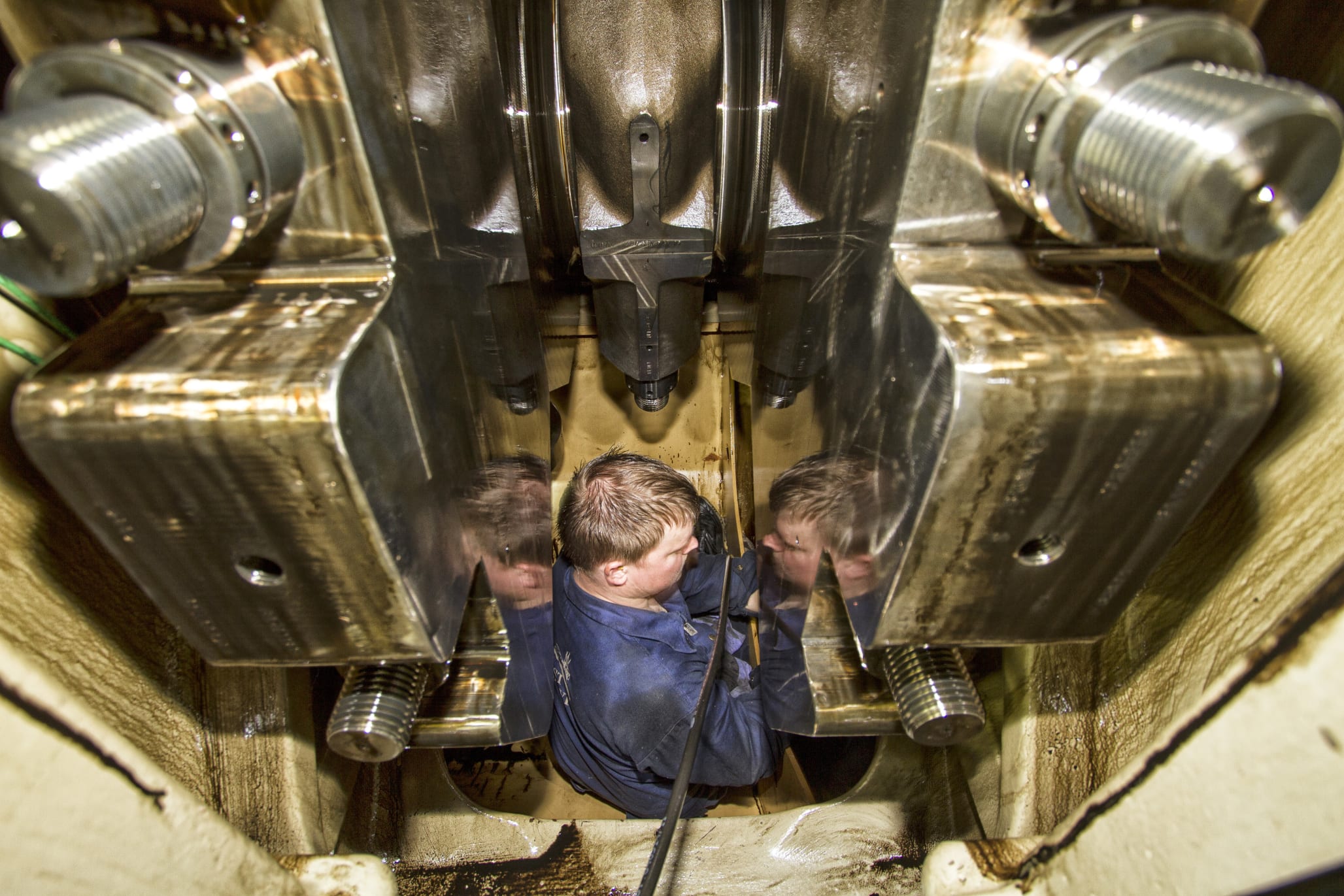Working in enclosed spaces can be hazardous, and specific procedures must be followed to make the work as safe as possible. Different persons on board, and sometimes ashore, has different responsibilities, and the orders and decisions must go through them. When everyone knows what to do and what is expected from them, the safety arrangement runs smoothly.

Go or no go – It’s for the responsible officer to decide, there are several hazards associated with an enclosed space entry. Photo: Jörgen Spång
Competent Person
A competent person is a person capable of making an informed assessment of the likelihood of a dangerous atmosphere being present or arising subsequently in the space. The competent person should have sufficient theoretical knowledge and practical experience of hazards that might arise, to be able to assess whether precautions are necessary.
Responsible Officer
A responsible officer is a person appointed to take charge of every operation where entry into a dangerous space is necessary. The responsible officer may be the same as the competent person or another officer. Both the competent person and the responsible officer may be a person ashore.
Go or No Go
It is for the responsible officer to decide, based on a risk assessment, the procedures to be followed for entry into a potentially dangerous space. If the assessment shows that there is no immediate risk to life or health, but it could arise during work in the space, certain precautions should be taken. These procedures will depend on whether the assessment shows:
- Minimal risk to life or health of a person entering the space at the time or at any later time.
- No immediate risk to life or health, but the risk could arise during work in the space.
- The risk to life or health is immediate.
Precautions for Entry
Down below are the following precautions that should be taken before an Enclosed Space Entry Permit, and further down in the text are they described more closely. The precautions are:
1. Identify potential hazards.
2. Test the atmosphere of the space.
3. Prepare a Permit To Work (PTW).
4. Prepare and secure the space for entry.
5. Check procedures and arrangements before entry.
6. Check procedures and arrangements during entry.
7. Check procedures on completion.
Now, a description of the precautions will follow that need to be checked before any Enclosed Space Entry. These steps are guidelines, but they developed to help you when you have to enter any enclosed space. Remember that it could be dangerous since the level of oxygen could be very low inside the tank, void or what sort of enclosed space you will enter. Be careful!
1. Identifying Potential Hazards
There are several hazards connected with an enclosed space entry. Some examples are:
- Inhalation of contaminated air.
- Contaminated air absorbed through the skin.
- Irritant or corrosive cargoes/vapors.
- Slips, trips, and falls while working in the enclosed space.
2. Space Atmosphere Test
This test should only be carried out by persons trained in the use of the equipment. Procedures connected with atmosphere tests are explained further in module 3 of this course.
3. Prepare a Permit To Work (PTW)
An Enclosed Space Entry should be planned, and a PTW must be issued before any entry. Procedures connected with PTW’s are explained further in module 4 of this course.
4. Prepare a Space for Entry
When opening the entrance to a potentially dangerous space, precautions should be taken in case pressurized or unpressurized vapor or gases are released from the space.
- The enclosed space should be isolated and be secured against the ingress of dangerous substances by blanking off pipe-lines or other openings and by closing valves.
- Valves should then be lashed, or by some other means used to indicate that they are not to be opened, and notices are to be placed on relevant controls.
- The officer on watch should be informed.
Where necessary, any sludge or other deposit liable to give off fumes should be cleaned out. It may in itself, lead to the release of gases, and precautions should be taken. The enclosed space should be thoroughly ventilated either by natural or mechanical means and then tested to ensure that all harmful gases are removed, and no pockets of oxygen-deficient atmosphere remain. Compressed oxygen should not be used to ventilate any space. If necessary, pumping operations or cargo movements should be suspended when an entry is being made into a dangerous space.
5. Check procedures and arrangements before entry
Access to and within the space should be adequately and well lighted. No source of ignition should be brought into the enclosed space unless the Master or responsible officer confirms that it is safe to do so. In all cases, rescue and available resuscitation equipment should be positioned ready for use at the entrance to the enclosed space. Rescue equipment means breathing apparatus together with fully charged spare cylinders of air, lifelines, and rescue harnesses, and torches or lamps approved for use in a flammable atmosphere, if appropriate. Means of hoisting an incapacitated person from the enclosed space may be required. The number of personnel entering the space should be limited to those who need to work in the space. When necessary, a rescue harness should be worn to facilitate recovery in the event of an accident. At least one attendant should be detailed to remain at the entrance to the enclosed space while it is occupied.
An agreed and tested system of communication should be established between any person entering the space and the attendant at the entrance. Also, between the attendant at the entrance to the enclosed space and the officer on watch.
Before entry is permitted, it should be established that entry with a breathing apparatus is possible. Any difficulties of movement within the space, or parts of the space, using breathing apparatus, lifeline or rescue harness should be considered, and any risk minimized. Also, any problem to remove an incapacitated person from the space should be considered and risk assessed. The lifelines should be long enough for the purpose and possible to attach firmly to the harness, but the wearer should be able to detach himself easily if he becomes tangled.
6. Check procedures and arrangements during entry
Ventilation should continue during the time the enclosed space is occupied and during temporary breaks. In the event of a failure of the ventilation system, all personnel in the space should leave immediately. The atmosphere should be tested periodically while the enclosed space is occupied, and personnel should be instructed to leave the space if the conditions deteriorate. Should a personal gas detector alarm sound, the enclosed space should be vacated by all persons immediately. If unforeseen difficulties or hazards develop, the work in the space should be stopped, and the enclosed space evacuated so that the situation can be re-assessed. Permits should be withdrawn and only re-issued, with appropriate revisions, after the situation has been re-assessed. If any personnel in an enclosed space feel in any way negatively affected, they should give the pre-arranged signal to the attendant standing by at the entrance and immediately leave the space.
Should an emergency occur, a general alarm should be activated so that back-up is immediately available to the rescue team. Under no circumstances should the attendant enter the space before help has arrived, and the situation has been evaluated to ensure the safety of those entering the space to undertake the rescue.
If air is being supplied through an airline to the person who is unwell, a check should be made immediately that the air supply is being maintained at the correct pressure. Once the casualty is reached, checking of air supply must be the priority. Unless he is gravely injured, e.g., a broken back, he should be removed from the dangerous space as quickly as possible.
7. Check procedures on completion
On the expiry of the “permit-to-work,” everyone should leave the space and any of the following actions should be taken:
- The entrance to the enclosed space should be closed or otherwise secured against entry.
- If the enclosed space is no longer dangerous, it should be declared safe for normal entry.
- If work is to continue with new personnel, a new permit should be issued, and personnel involved have to sign the new permit.


